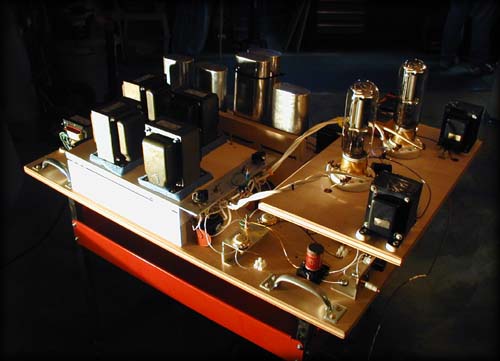
il Monstro, an 845:845 Power Amplifier
I had been plotting to build a pair of monoblock tube power amplifiers since the second iteration of the Foreplay kit, but with the house renovations and other distractions I could not scrape together the cash to buy a Parabee kit from Bottlehead, and so the wheels kept spinning...

In the meantime I read everything I could find and eventually fell under the evil influence of a notorious group known as the Dixie Bottleheads. The great thing about groups like this is that you get the chance to hear things you might never encounter in the 'real world'. The horrible thing is that most of these things sound damn good and with the encouragement of others, well, plans begin...
Summer of 2001 I listened several times to a fine 211 amp built by Dixie Bottlehead (that'd be dBH in eMail-speak) Randy Worthington, and began to think about building an amplifier using it's lower-mu cousin, the 845. By early Fall a bunch of the dBH folks travelled out to Seattle to VSAC 2001 and hosted a room. While there I had a chance to discuss the 845 amp project with some of the other attendees and found that many folks were thinking along the same lines - of building an 845 amp that did not drive the tubes flat out, but instead at lower voltage for less power and clean sound.

The opinion came up several times that the 845 run in this 500V B+ sweet spot sounded like a big 45 tube. With the price of new Chinese 845 tubes hovering around $40 ea, you could buy a lot of tubes and grade out some special ones and still spend far less than most other power tubes.
VSAC 2001 - the most fun I have ever had at a conference on any subject! Found the Sakuma design and started noodling on a parafeed adaptation. This design will use massive amounts of iron, so some creative approach to parts and/or financing will be needed.
D i s c l a i m e r:
Tubes mean big voltages. Big tubes mean bigger voltages and even more current than most tube amps.
The voltages in this amplifier design can stop your heart and then you'll be dead.
Be careful! Follow all the suggestions of folks who are wiser than me and don't
even try this if you don't know what you are attempting.
Be responsible for your own actions and don't sue me, OK?
In this page:
- Sakuma Inspiration
- Design Description
- B+ (High Voltage) Power Supply
- Filament Power Supply
- Signal Section
- Extras: Things not Shown in the Schematic
- Chassis Design
- How does it Sound?
- Oswald's Mill 2004
Sakuma-San Inspiration
The key circuit inspiration for this amp is a Susuma Sakuma design using an 845 to drive an 845. Sakuma believed that the driver of an amplifier was the limiting factor for great sound...
"To make a big voice, powerful lungs are needed. But your throat only controls the current of breath. I regard my preamplifier as our lungs and my power amplifier as the throat. If you compare the tone of the 310A / 300B with WE300B / 300B, then you will understand my point".
![]() View Sakuma 845:845 Schematic
View Sakuma 845:845 Schematic
![]() Original Schematic at Japanese 'Direct Heating' site
Original Schematic at Japanese 'Direct Heating' site
Many other 845 projects can be found online, and some are published - Sound Practices showed a version of J.C.Morrison's Dinosaur 50 amp with 845 tubes running at low voltage.
When I returned to Atlanta I started working on this project seriously, and I'll cover some of the highlights here. To shorten this page and reduce confusion (and boredom) I've separated the early part of the saga and moved it to:
... Be Warned: this is a very long story. Three years of planning, building, re-building, moving, re-building, testing, failures, re-building, and finally some success along the way. I'll try to make it interesting, but first I have to get it all out of my notes and into the site!
So forgive me if this page and the origins page writhe around for a while - I want to get all of this squared away for posterity, but the rest of my life intrudes most of the time. And after all, this is supposed to be a hobby. Isn't it?
And for those of you who just want the schematic:
![]() Most Recent il Monstro 845:845 Schematic (November 2008)
Most Recent il Monstro 845:845 Schematic (November 2008)
Update - after five years of running the Hammond 300BX main power trannies, I managed to kill two - that's a 50% mortality rate, even while running them within Hammond's published specs. In 2008 I asked Jack Elliano of Electra-Print to wind some custom replacements ( Replacement Transformers [2 required]: 120VAC Nominal Primary, 550-450-0-450-550 secondary @ 250mA, Filament 1 - 5V C.T. @ 3A [for 83 rectifier], Filament 2 - 6.3V C.T. @ 6A [for future timing relays, etc.] - M19 laminations, Vertical mount, 12 inch leads) About 50% larger than the Hammond units, these new transformers have been excellent and I'm sure Jack would be happy to wind some other parts as well.

il Monstro is alive! Breadboard, circa 2002, Front: 845 tubes and oneElectron PRC-2 plate chokes, Back: Lots of huge GE oil caps and B+ chokes, Left: Filament supply with CLCLC filters.

il Monstro circa 2003, right channel shown
Design Description

It's really really heavy.
il Monstro weighs 282 pounds (that's 128 kilograms!) split into four boxes. Dual mono power supplies feed dual mono signal chassis via sheilded umbilicals. It definitely helps to get a friend to help carry one of the 100 pound power supplies if you have to do stairs.
This amplifier is an all-out attack on good sound using as much crazy iron as needed and the best craftsmanship I can muster. But it really is nothing new, just another design made while standing on the shoulders of the giants of tube design and a collection of all the good ideas I could glean off the internet in the past five years.
The 'Thanks, because without you it couldn't be done' list has to include: Dan Schmalle and Paul Joppa of Bottlehead, Ron Welborne, the late great 'Buddha' Camille, Harvey 'Gizmo' Rosenberg, Art Dudley and lamented Listener magazine, all the contributors to VALVE magazine, and a special nod to the Dixie Bottleheads who never gave up on me finishing this thing - Phil Sieg, Jim Dowdy, Rick Henthorn, Jeff LaLonde, Brad Brooks, Jeffrey Jackson, Ken Lochridge, Steve Killian, Grainger Morrison, and the rest of the gang - I owe you all a beer.
B+ (High Voltage) Power Supply
The power supply is a brute force design, with everything overbuilt. Regulation is achieved by tuning the circuits for the constant load.
Rect -- C --- L --- C --- L --- C --- L --- C --- Choke - 845 Driver
83 3uF 10H 10uF 10H 120uF 12H 24uF 48H
82ohm 82ohm | 155ohm 304ohm
| 507VDC
| .001VAC
| 63V Bias
|
----------------- Choke - 845 Output
48H 552VDC
304ohm .001VAC
65V Bias
- B+ used an oversize Hammond 300BX power tranformer - using the 110V 'world power' inputs.
The 300 series Hammonds are built much better than the 200 series power transformers.
One of the original 300BX trannies died after 6 months use and was replaced by Hammond. And then another one died. In 2008 I asked Jack Elliano of Electra-Print to wind some custom replacements that have worked wonderfully ( Replacement Transformers [2 required]: 120VAC Nominal Primary, 550-450-0-450-550 secondary @ 250mA, Filament 1 - 5V C.T. @ 3A [for 83 rectifier], Filament 2 - 6.3V C.T. @ 6A [for future timing relays, etc.] - M19 laminations, Vertical mount, 12 inch leads )
- The rectifier is a mercury vapor type 83 - available as vintage only,
these are probably considered hazardous waste.
- Small cap input - 3uF 660VAC GE motor-run cap.
Using a small cap input give some of the benefits of choke input but allows the designer
to adjust the output voltage by varying the size of this cap.
The 83 rectifier is not compatible with large input caps at these voltages.
Motor-run caps are used for good sonics, availability is various sizes, and toughness.
- Input Choke - Hammond 193J 10H 200mA, followed by 10uF 660VAC GE motor-run cap.
- Second Choke - Hammond 193J 10H 200mA, followed by paralleled 60uF 370VAC GE motor-run caps.
The filter chokes are rotated relative to each other to reduce electromagnetic coupling.
- Decoupling Filter - Hammond 193B 12H 100mA, followed by 24uF 660VAC GE motor-run cap. This stage feeds the input 845 only, it reduces B+ feedback between the input and output 845 tubes. This stage is located inside the signal chassis to provide damping for any noise pickup in the umbilical.
Filament Power Supply
Each 845 tube requires 10V at 3.25 Amps to operate - with a thoriated tungsten filament ample free electrons are present in the charge space of this triode; this is one of the reasons I believe the 845 sounds so powerful.
As in any directly heated triode (DHT) the filament *is* the Cathode of the tube, so clean and quiet power is critical. The filament supply for il Monstro is built similarly to the B+ supply, using chokes on the low-voltage supplies to smooth the ripple. This is unusual for tube amplifiers, but avoids the 'dead' sound some folks have reported with DC filaments in DHT amplifiers. 3.25A per 845 means that conventional solid-state regulation is not possible. Each 845 has a dedicated filament supply that is grounded via the center-tap of the cathode hum pots shown in the schematic.
- Each 845 has a dedicated Hammond 166R12 filament transformer (12.6VAC with center tap at 8A)
- Full Wave Bridge Rectifier uses 10A 50V Shottkey diodes
- Smoothing is via CLCLC using 10,000uF 70V CDE computer supply caps and Hammond 193V 0.15H 3.5A chokes.
These chokes get very warm in operation, they are also heavy - 11 pounds each.
I normally try to derate any Hammond iron since their specifications are generally limits,
but there is no other viable off-the-shelf iron for this position.
- Voltage is adjusted by paralleling the first choke with high-power resistors
to push the filament voltage above 10V in operation. This is critical to the sound of the amplifier,
starving the filaments will kill the dynamics of the music.
- Filament caps are located in the raised box with the four filament chokes bolted to the top. The bridge rectifiers and filament transformers are under the top plate so their noise is largely shielded from the filter components. The filament chokes are rotated relative to each other to reduce electromagnetic coupling.
Summary of Design: Signal Section
Sakuma designs use input transformers and power tubes as drivers with interstage transformers. Interstage and output transformers are classic single-ended Tamura iron designed for significant B+ current.
il Monstro uses input transformers, but the driver and output tubes use parallel feed, an old Western Electric discovery. Parallel feed separates the B+ power from the output coils so you can optimize both - B+ can use inductors with more inductance, and the output transformer does not have to be designed to avoid saturation from the B+ current for the tube.
But at a cost, twice as much iron in the amplifier.
The topology was never commercially successful.
The circuit is pretty basic: two tubes with iron on both sides of each. An input transformer provides most of the voltage gain since the 845 has a relatively low amplification factor. Here are the relative signal AC levels in the circuit:
1.0VAC --+
| Altec/Peerless 15095 input
5.0VAC --+
( ) 845 Driver Tube
21.81VAC --+
| Magnequest EXO-173ni Autoformer
21.67VAC --+
( ) 845 Output Tube
81.7VAC --+
| Magnequest EXO-50 output XFMR
7.6VAC --+
(( )) Speaker Binding Posts
With input and output transformers and no oscillation, the amplifier is very stable. Input cables can be connected and disconnected without thumps. Speaker cables can also be attached and detached without worry or thumps as long as the input signal is muted.
The vintage Altec/Peerless 15095 microphone stepup used as an input transformer allows simple switching of absolute phase as shown on the schematic; this is incredibly useful in a high-resolution system because phase sometimes varies from album to album.
Another unique feature of this amplifier is the use of stepup grid choke coupling between the stages. Since I made the decision early to build parafeed choke loading into the design there was no real need to use a full interstage transformer to drive the output tube. Mike LeFevre of Magnequest suggested that I might try a newly revived Peerless design, the EXO-173 center tapped autoformer, as an interstage coupling device.
Driving the EXO-173 via the center tap with one end grounded gives a stepup at the grid that offsets the insertion loss. The output tube grid gets the goodness of a grid choke with low DC impedance to ground but high AC isolation, and the signal path is much more direct than a typical interstage transformer.
Both 48 Henry parafeed chokes are oneElectron, and the output trannies are Magnequest EXO-50 pinstriped nickel and iron - see a pattern here? I tried to save money by using Hammond iron in the brute force power supply positions, to splurge on Magnequest and Peerless signal iron, and compromised with mid-priced oneElectron plate chokes.
Input connectors
RCA and XLR inputs connect to the input transformer primary through a DPDT mini-toggle with coin silver contacts.
The toggle switch inverts the connection to the primary allowing absolute phase control.
I've been on a minimalism kick for connectors going back a few years, but I did use some chunky Cardas input jacks I had in the parts bin.
Input transformer
Altec/Peerless 15095 or 15095A models 15k:600 rating,
or a 5:1 voltage ratio. 15095 and 15095A have same ratings but slightly different pinout.
These small octal-plug microphone transformers are fairly plentiful, popping up on eBay regularly,
and they are a real bargain considering the materials and bandwidth.
Case looks to be mu-metal with Altec red graphics for pinout and identification.
Parafeed Chokes
oneElectron PRC-2 48H at 75mA
- these chokes have two sections and can be wired in series or parallel,
so they can easily be re-used for another project as 12H 300mA power supply chokes.
Not the most beautiful finish on these, the end bells and laminations needed quite a bit of
sanding and primer to get a good finish compared to most of the Hammond iron in the project.
Interstage autoformer
Magnequest EXO-173ni (nickel) centertapped autoformer.
Brass end bells, located under chassis between the 845 sockets.
Driver parafeed coupling cap: 3uF 660VAC GE motor-run oil capacitor
Output Transformer
Magnequest EXO-50 5k 20W parafeed output tranny.
Parafeed output trannies are optimized for zero DC - no air gap and hideous amounts of
inductance for extended bandwidth. The EXO-50 has a multi-tapped secondary that can be
configured for 4, 8, or 16 ohm speaker connections, so il Monstro has a Euro-style terminal
strip between the binding posts underneath to vary the output connections.
Output parafeed coupling cap: 2uF 600VAC Sprague 'bathtub' oil capacitor
Binding posts: Minimal metal, gold plated with plastic hex nuts.
Wiring
Where possible connections are made directly with component leads.
In other places signal wiring is 27ga fine silver and ground wiring is 18ga fine silver.
Some teflon tubing is used for short protection on bare conductors.
Bias network
Hum pots are 100 ohm 3W with discrete 100 ohm 3W WW resistors between wiper and end terminals.
Cathode bias resistors are 1k ohm 50W wirewound pots. Big suckers.
The cathode resistors are bypassed with SCR 400V polypropylene film capacitors.
Extras: Things not Shown in the Schematic
- 'Buddha' CMC at input - see Mambo schematic for details - this is a cap and CMC filter where the AC enters the PS chassis
- RC filters in B+ - Sometimes you get the bear and sometimes the bear gets you. CLC pi filters are generally stable and reliable in high-voltage filter designs, but sometimes things go bump in the night and there is an unforseen interaction - a resonance that must be dealt with. For some reason I had a tank resonance in il Monstro's B+ filtration, but with some help from Voltsecond I was able to add some simple RC filters in parallel to dampen the resonances without affecting the low impedance of the original PS design.
- Switchable 50k ohm 50W bleeder resistor in B+ at the decoupling filter stage (switch in ground leg)
- High-voltage supply switch on AC supply to the Hammond 300BX power transformer allows testing of the filaments without firing the 83 rectifier or high-voltage
- Shielded 18ga twisted pairs run the filament DC to umbilical connector
- Shielded AC lines to switches at front of PS - using grounded copper braid tubing
Chassis Design
As an industrial designer I really enjoy the whole chassis design and construction process. The case design for il Monstro builds on earlier patterns I developed for the Mambo preamp; figured maple frames with paduak trim and 13ga copper top plates. The new wood frames had to be able to support much more weight than a preamp, so they are full 5/4 thickness with glued-in ledge strips for the copper top plates. The painted maple black base frame adds overall height to hide deep internal transformers. The stepped appearance of base frame, narrower side frame, and top plate with set back components gives an impression of stability. The radiused edges better show off the maple figuring while blending with the rounded shapes of the transformer covers.
Chassis Plates
13ga copper (about 3mm thick). Signal chassis plates are 12 x 18 inches and PS plates are 18 x 18 inches.
PS also has a diagonal brace of heavy aluminum angle to help support the massive transformers.
Chassis plates are backed with 1/8 inch sorbothane sheet for vibration control.
Signal chassis sub-chassis
Made from .250 inch thickness polycarbonate, the subchassis in each signal box holds the 845 sockets,
the bias and hum pots, the EXO-173 interstage autoformer, and the test points.
This provides additional vibration dampening, plus allows the main signal components to be removed all in one assembly for repairs or changes.
Stainless socket head bolts with stainless nylock nuts were used for all chassis plate attachments.
Transformer detailing
The Magnequest transformers already had good finishes and brass hardware,
but the oneElectron and Hammond iron had a variety of finishes and hardware.
Drips of varnish were common on bell ends. Urk. It was a significant effort to take every transformer apart,
to sand and repaint all of the end bells (bronze hammertone) and also the laminations (semi-gloss black).
During reassembly gaskets were cut from automotive cork/rubber gasket sheet and installed between
the end bells and laminations to control vibration.
All screws were replaced with brass allthread and acorn nuts with rubber washers.
Transformers were mounted to chassis with hidden sorbothane pads under the lamination stacks and rubber/composite washers.
All transformers were grounded - end bells had one bolt mounted with toothed washers to ground the
iron to the chassis plate for safety.
Tube sockets
83 rectifier uses a standard ceramic UX-4 socket, rubber mounted to the PS chassis plate.
845 tube sockets are gold flash ceramic sockets from tubesandmore.com - as covered above they are
attached to the polycarbonate subchassis in the signal boxes.
There is an additional octal socket on the power supply beside the 83 socket that had been used for a timer relay but is now empty.
Umbilicals
One of the more complex areas of the assembly is the umbilical design.
A female Neutrik NL8MPR jack is mounted to each PS chassis,
and the umbilical is permanently connected to the signal chassis.
Umbilicals are long enough to place the PS under the signal chassis in a stand, or they can be laid out side by side. PS and signal chassis are mirror images and interchangeable.
The Neutrik Speakon connectors are only rated for 300VAC or so, but if you look at the design they are well-insulated. Each conductor has it's own screw-down clamp with plastic fences between the clamps. All contacts are recessed in both sides of the connectors, a clever design. Very nice for the money, much less $$ than most of the other connectors I considered.
I used plenum rated video coax for all lines - this stuff has foamed teflon insulation, very tough.
6 coax lines:
+ driver tube filament 18ga solid copper plenum coax - driver tube filament 18ga solid copper plenum coax + output tube filament 18ga solid copper plenum coax - output tube filament 18ga solid copper plenum coax + B+ high voltage 20ga solid copper plenum coax - signal GND 20ga solid copper plenum coax + all coax shields tied to chassis GND at each end
Seven contacts are used on the Neutrik connector - wires bundled into 3 pairs of coax covered with fiberglass sheathing (fiberglass I have on hand will not stretch over more conductors). This leaves one contact free in case I decide to try fixed bias for the output tube later.
AC Wiring
Wall supply cable is hard-wired to amplifier with 12ga solid core THHN house wire,
braided with fiberglass sheath and a Hubbell plug.
Chassis GND posts
Each chassis has a gold speaker binding post bolted directly to the chassis in case of external ground loops.
Not needed so far, but nice to have.




And How does it Sound?
I took the breadboard amp up to Knoxville for the September 2002 Dixie Bottlehead meeting at Phil Seig's house and it was a stunning success in mono. The goal of all of this for me is an involving system, one that make you forget everything about thinking 'sound' and instead makes the music the most important thing. That day at Phil's this amp achieved that goal, both playing through Phil's CAR T1s and through a pair of Terry Cain's Voigt pipes with Fostex drivers.
When the record was started everyone stopped talking, and they listened for two whole songs. This may seem like a strange comment, but at these meetings there is a tendency to murmur away at the back of the room and catch up with folks after you get the general sound of a new component. If you really want to listen you just move to the front. We had just listened to a pair of excellent high-power SET 845 amps (417:300B:845) built by Jeff LaLonde before il Monstro, but this was different.
It sure proved to me that the Sino tubes are not limiting this design!
Afterwards, everyone was complimenting the breadboard amp to the point where it was embarrassing. I only hope that the amp sounds this good when I transplant it into stereo with housings...
 In Spring 2004 Blithe and I finally had a dBH meeting at our house in Charlotte, NC -
and il Monstro was finally singing, with a tiny bit of hum remaining after Rick Henthorn
waved his magic digital oscilloscope over it in the lab we hauled the carcass upstairs and
listened to it for hours. Very nice. It turned out that the residual hum was the sneak ground
between the driver and output fils - later solved by using dedicated power transformers.
In Spring 2004 Blithe and I finally had a dBH meeting at our house in Charlotte, NC -
and il Monstro was finally singing, with a tiny bit of hum remaining after Rick Henthorn
waved his magic digital oscilloscope over it in the lab we hauled the carcass upstairs and
listened to it for hours. Very nice. It turned out that the residual hum was the sneak ground
between the driver and output fils - later solved by using dedicated power transformers.
Oswald's Mill 2004
Still, the amp sounded dang good in comparison with Rick Henthorn's 'Limbo' parafeed 71a subwatt amplifier and Steve Killian's Bottlehead Parabees (300B parafeed kit amps).
 Well, after listening to the fully shaken-out-and-stable il Monstro for several weeks in the Fall of 2004,
Steve Killian and I drove up to Pennsylvania for the
weekend for the Oswalds Mill
festival in mid-November. I took il Monstro and a re-housed lead-acid-battery-powered Sonic Impact digital amplifier
(talk about contrasting DIY philosophies!) for show and tell, but we never got the chip-amp into the system.
Well, after listening to the fully shaken-out-and-stable il Monstro for several weeks in the Fall of 2004,
Steve Killian and I drove up to Pennsylvania for the
weekend for the Oswalds Mill
festival in mid-November. I took il Monstro and a re-housed lead-acid-battery-powered Sonic Impact digital amplifier
(talk about contrasting DIY philosophies!) for show and tell, but we never got the chip-amp into the system.
Jonathan Weiss, the host, has an incredible system in the huge main room up there based on RCA theater horn technologies - bass horns, segmented mid-horns with RCA 1428 field-coil drivers, and conical treble horns, also with field-coil drivers. Astounding detail and presence with these speakers, even in a huge room with 30 inch thick stone walls. Alternate speakers used that weekend included other RCA theater horns and also a mismatched pair of 6 inch (?) field-coil radiators.
So I finally was able to hear il Monstro with a truly state of the art (!) high-efficiency speaker system and it was a mind-warping, expectation-altering experience.
At some point on Saturday we had a one-on-one comparison between il Monstro and Jonathan's vintage 65-year-old rack-mount RCA (not Western Electric!) 9355 push-pull 845 theater amp with a custom vintage pentode to 300B driver amp (and that driver amplifier sounded great all on it's own), I believe those things were going for $40-50k in Japan as a highly-coveted piece of functional classic audio. About six feet high and very industrial, but a sweet sound.
Jonathan had a 45RPM LP version of Louis Armstrong singing 'St. James Infirmary' a classic old New Orleans jazz piece that was riveting to hear on his system. Certainly you could hear the classic descriptions of SE v. PP in the presentations - il Monstro was a little more woolly in the bass but had better immediacy in the voice, while the WE 845 PP amp had better bass control but was maybe a touch glassier in the mids and high frequencies. What great company to even be competitive with an amplifier like that!
Or, as GaryB said:
It truly was a great meeting. I was at the Mill 3 years back but haven't had a chance
to return since. As others have pointed out, the gear sounded very good with many of the
amps doing a fine job. The Mill is such a big space that even with the huge RCA horns,
an 8W 300B amp isn't enough power. The big 845 SE amps or the push pull amps really were
needed to bring things to life.
Once the amps were matched to the speakers (either Jonathans's big horns) or the RCA LC-9s
produced truly amazing sound. The sound of Louis Armstrong singing St. James Infirmary on vinyl
made you think he'd come back from the dead.
A terrific weekend all around to hear those systems in that space.
BTW, on my way out of the Mill, Jonathan was also congratulating me on the sound of my amp and going on about how 'big' amps sounded in his system. Gary was not the only one to assume that il Monstro was a more powerful amp from the sound it produced that weekend. As Grover Gardner has said about the 845 sound - it just powers through. I didn't have the heart to tell him il Monstro was only putting out 5-6 clean Watts.



